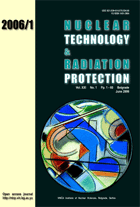
RADIATION MONITORING USING IMAGING PLATE TECHNOLOGY: A CASE STUDY OF LEAVES AFFECTED BY THE CHERNOBYL NUCLEAR POWER PLANT AND JCO CRITICALITY ACCIDENTS

June 2006
UDC 621.039+614.876:504.06
YU ISSN 1451-3994
....Back to Contents
Pages: 41 - 47
Authors: Shinzo KIMURA, Sarata K. SAHOO, Kunio SHIRAISHI, Yoshito WATANABE, Tadaaki BAN-NAI, Ivan P. LOS, Vitaly N. KORZUN, Nikolay Y. TSYGANKOV, Pavlo V. ZAMOSTYAN, Valery E. SHEVCHUK
AbstractThis paper describes the use of a photostimulable phosphor screen imaging technique to detect radioactive contamination in the leaves of wormwood (Artemisia vulgaris L.) and fern (Dryopteris filix-max CL. Schoff) plants affected by the Chernobyl nuclear power plant accident. The imaging plate technology is well known for many striking performances in two-dimensional radiation detection. Since imaging plate comprises an integrated detection system, it has been extensively applied to surface contamination distribution studies. In this study, plant samples were collected from high- and low-contaminated areas of Ukraine and Belarus, which were affected due to the Chernobyl accident and exposed to imaging technique. Samples from the highly contaminated areas revealed the highest photo-stimulated luminescence on the imaging plate. Moreover, the radionuclides detected in the leaves by gamma and beta ray spectroscopy were 137Cs and 90Sr, respectively. Additionally, in order to assess contamination, a comparison was also made with leaves of plants affected during the JCO criticality accident in Japan. Based on the results obtained, the importance of imaging plate technology in environmental radiation monitoring has been suggested.
Key words: CNPP accident, JCO criticality accident, imaging plate technique
FULL PAPER IN PDF FORMAT (1.26 MB)
Last updated on September, 2010